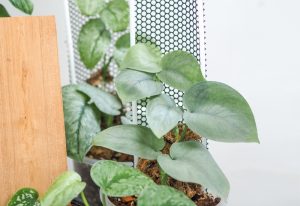Satin pothos, also known as Scindapsus pictus, is a popular houseplant known for its stunning foliage and easy maintenance. While typically grown in soil, many indoor gardening enthusiasts might wonder if this attractive plant can thrive in water. Exploring the possibility of growing satin pothos in water opens up new avenues for creative plant displays and low-maintenance care.
Interestingly, pothos plants, in general, can indeed live in water, as long as they receive sufficient nutrients. Some individuals choose this method to cultivate pothos as semi-aquatic plants for fish tanks or to simply observe the fascinating growth of roots in water. However, the key to success lies in maintaining nutrient-rich water and an ideal environment for the plant.
Although there are no significant advantages in growing pothos in water as opposed to soil, this novel approach offers an exciting way to diversify your houseplant collection. Ensuring proper care by providing dechlorinated tap water and refreshing the water every one to two weeks will help guarantee that your satin pothos remains a striking addition to your home for years to come.
Can Satin Pothos Live in Water?
Satin Pothos can indeed live in water, as long as it receives the necessary nutrients and care. Growing these plants in water is an alternative to traditional soil-based cultivation methods. When propagating Satin Pothos cuttings, you can choose to leave them in water permanently, since they will continue to grow and develop roots.
To ensure your Satin Pothos thrives in this environment, consider the following recommendations:
- Provide an ideal temperature range of 65 to 85 degrees Fahrenheit, as these tropical plants are sensitive to cold conditions. Maintaining optimal growth temperatures is crucial to avoid cold damage.
- Ensure proper humidity levels around 40 to 50% relative humidity for your plant. Inadequate humidity can lead to issues, such as browning leaf tips, so it’s important to maintain the ideal conditions.
- Add liquid fertilizer to the water to supply the essential nutrients that the plant would typically obtain from soil. Without these nutrients, the Satin Pothos might not thrive in water-based environments.
Remember, plants grown in water also require attention to their environment and water quality. With careful monitoring and proper care, your Satin Pothos can live in water and provide lush, beautiful foliage for years to come.
Benefits of Growing Satin Pothos in Water
Low Maintenance
One of the main advantages of growing Satin Pothos in water is its low maintenance nature. Unlike traditional soil-based plants, pothos in water do not require soil changes or repotting. Additionally, you won’t have to worry about overwatering or underwatering, as the plant will have constant access to the water it needs. To provide vital nutrients, simply add a liquid fertilizer to the water occasionally. It’s important to note that Satin Pothos can live in water indefinitely as long as they receive proper nutrients.
Versatile Display Options
Growing Satin Pothos in water allows for unique and versatile display options. You can choose from a variety of containers, such as clear or colored glass, to show off the plant’s roots and complement your interior design. Transparent containers, in particular, work well, as they allow for easy root visibility and make for an interesting visual element in any room. Feel free to get creative with the container choice, matching it to your style and preferences.
Reduced Pest Issues
Another benefit of growing Satin Pothos in water is the reduced likelihood of pest issues. Soil-based plants are more susceptible to common pests like gnats, mealybugs, or spider mites. By eliminating the use of soil, you also eliminate the pests’ ideal living environments. As a result, you can enjoy a healthier and happier satin pothos with fewer concerns about pest infestations.
Growing Satin Pothos in water is a fantastic option for those looking for a low-maintenance, attractive, and pest-resistant houseplant. With its versatility in display options and ease of care, it’s a perfect choice for both new and experienced plant enthusiasts.
How to Grow Satin Pothos in Water
Selecting a Container
Choosing the right container plays a crucial role in the successful growth of Satin Pothos in water. Opt for a transparent glass or plastic container with a wide opening to provide ample space for root growth. The container should be deep enough to hold water and accommodate the cutting’s roots without completely submerging the stem or leaves.
Preparing the Cutting
To ensure healthy growth of your Satin Pothos in water, you’ll need a strong and healthy cutting. Carefully remove a stem from an existing plant using clean scissors or pruning shears. Ensure the cutting has at least one or two nodes – the points where leaves emerge from the stem. Trim off any leaves that would be submerged in water, as they can rot and create an unhealthy environment for your plant.
Maintaining Water Levels and Quality
Regularly monitoring and maintaining water levels and quality is essential for the successful growth of Satin Pothos in water. Replace the water in the container every one to two weeks, or whenever it looks brackish. In addition to fresh water, add a liquid fertilizer to provide the necessary nutrients for robust growth. Ensure the fertilizer is suitable for Satin Pothos and follow the manufacturer’s instructions for proper dosage.
It’s also important to keep your Satin Pothos in a location with bright, indirect light to promote healthy growth. Although these plants can tolerate low light conditions, too much direct sunlight may cause leaf burn or stunted growth.
In conclusion, growing Satin Pothos in water is a simple and low-maintenance process. By selecting an appropriate container, properly preparing the cutting, and maintaining water levels and quality, you’ll be well on your way to enjoying a thriving, healthy plant.
Potential Challenges
Growing satin pothos in water can be a viable option for your houseplants, but there are some challenges to be aware of. In this section, we will discuss potential issues, such as lack of nutrients, root rot, and algae growth.
Lack of Nutrients
While satin pothos can survive in water, it’s essential to be mindful of the nutrient content in their environment. Water alone does not provide all the necessary nutrients for healthy plant growth. To ensure your pothos thrives, consider adding a liquid fertilizer to the water every few weeks. This will help provide the essential nutrients needed for proper growth and maintenance.
Root Rot
Root rot may occur in satin pothos grown in water due to excessively moist conditions. To help prevent this issue, make sure to change the water every two to three weeks to maintain proper hygiene within the container. Additionally, monitor the plant for any signs of root rot, such as yellowing leaves or wilting.
Algae Growth
Algae growth is another concern when growing satin pothos in water. To minimize algae buildup, it’s best to use an opaque vase that blocks more light and discourages growth. If you decide to use a clear vase instead, be prepared to clean the inside of it more often to keep algae in check. Another preventive measure is to use chlorine-free water in the vase, which helps reduce algae growth.
In conclusion, while growing satin pothos in water can be a successful endeavor, it’s essential to be mindful of potential challenges. By addressing these issues through proper nutrition, cleanliness, and preventive measures, your pothos plant can flourish in a water-based environment.
Converting Satin Pothos to Soil
Satin pothos can indeed be transferred from a water environment to soil, just as they can be propagated in water or directly in the soil. To make this transfer, follow these steps:
- Gently remove the plant: First, carefully take the satin pothos out of its water container, making sure not to damage the roots.
- Clean the roots: Next, gently remove any debris or lingering soil from the roots. Rinse them with bottled water or tap water that has been allowed to sit for 24 hours prior to ensure optimal results.
- Prepare the pot: Choose a pot with drainage holes to help prevent root rot. Fill it with a well-draining potting mix, such as a mix of peat moss and perlite, designed for tropical plants.
- Plant the satin pothos: Create a small hole in the potting mix, and carefully place the roots of the pothos plant into the hole. Gently cover the roots with the potting mix, ensuring the plant is secure and well-supported.
- Water the plant: After planting, thoroughly water the satin pothos, allowing any excess to drain out of the drainage holes. This will help settle the soil around the roots.
- Adjust lighting: Place your new satin pothos plant in a spot that receives bright, indirect light. Too much intense sunlight can cause the leaves to turn yellow or brown, so be mindful of the plant’s lighting needs.
- Monitor temperature and humidity: Satin pothos thrive in temperatures between 65 and 85 degrees Fahrenheit, as well as a relative humidity of 40 to 50%. Ensure that the plant’s environment meets these requirements to promote healthy growth.
By following these steps, you can successfully transfer a satin pothos plant from water to soil, setting it up for continued growth and enjoyment.
Helpful Video

My name is Daniel Elrod, and I have been houseplant love ever since I was 17. I love how much joy they bring to any room in the home. I’ve always been amazed at how a few pots of flowing leaves can turn a drab and sterile office into an inviting place where people love to work at.

















































































































































































































































